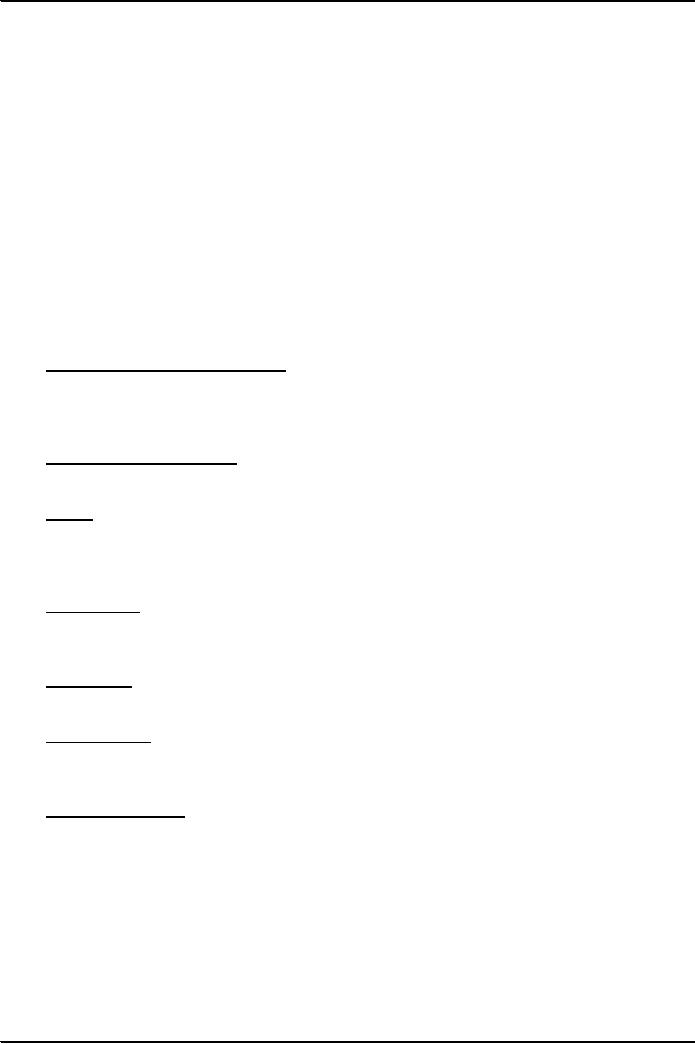 |
Concept of Audit Evidence |
| << SUBSTANTIVE PROCEDURES |
| SUFFICIENT APPROPRIATE AUDIT EVIDENCE AND TESTING THE SALES SYSTEM >> |

Fundamentals
of Auditing ACC 311
VU
Lesson
22
AUDIT
EVIDENCE
Auditor
should obtain sufficient appropriate
audit evidence to be able to
draw reasonable conclusions
on
which
to base the audit
opinion.
Concept
of Audit Evidence
Audit
evidence is all the information
used by the auditor in arriving at the
conclusions on which his
opinion
is
based and includes the
information contained in the accounting
records underlying the financial
statements
and other information. It is obtained
from audit procedures
performed during the course
of
audit
and may include audit
evidence obtained from other
sources such as pervious audits
and a firm's
quality
control procedures for
client acceptance and
continuance.
Accounting
records generally include the records of
initial entries and
supporting records, such as
checks
and
records of electronic fund transfers;
invoices; contracts; the general
and subsidiary ledgers,
journal
entries
and other adjustments to the
financial statements that
are not reflected in formal
cost allocations,
computations,
reconciliations and disclosures. The
entries in the accounting records
are often initiated,
recorded,
processed and reported in the
electronic form. In addition, the
accounting records may be
part of
integrated
systems that share data
and support all aspects of the entity's
financial reporting, operations
and
compliance
objectives.
Auditor
obtains most of the audit evidence
from accounting records of the
entity. If accounting records
do
not
provide sufficient audit
evidence, the auditor obtains other
audit evidence.
Other
information that the auditor
may use as audit evidence
includes:
� minutes
of meetings;
� confirmations
from third parties,
� analysis'
reports;
� comparable
data about competitors
(benchmarking);
� controls
manuals;
� information
obtained by the auditor from such
audit procedures as inquiry, observation;
and
inspection;
� and
other information developed by, or
available to, the auditor
that permits the auditor to
reach
conclusions
through valid
reasoning.
Sufficient
appropriate Audit
Evidence
Sufficiency:
The
measure of quantity of audit
evidence.
Appropriateness:
The
measure of quality i.e.
relevance and reliability in
providing support of
detecting
misstatements in account balance
classes of transactions and
disclosures and relevant
assertions.
The
quantity of audit evidence
needed is affected by:
- the risk of
misstatement (the greater the risk, the
more audit evidence is
likely to be required); and
- the
quality of such audit
evidence (the higher the quality, the
less may be required).
Accordingly
sufficiency and appropriateness are
interrelated. However, merely
obtaining more audit
evidence
may not compensate for
its poor quality.
Audit
evidence obtained through same
audit procedures may be relevant to
certain assertions but
not
relevant to
other assertions.
The
auditor often obtains evidence
about an assertion from
different sources or of different
nature.
Evidence
about an assertion is not a
substitute for evidence
regarding another assertion.
Sources
of obtaining Audit
Evidence
i)
Internal
source -
through accounting system,
management, employees, underlying
documentation
etc.
ii)
External
source -
third parties, i.e.
suppliers, customers bankers
legal advisers and other
parties
who
have knowledge of the enterprise.
82

Fundamentals
of Auditing ACC 311
VU
Nature
of Audit Evidence
i)
Visual
ii)
Oral
iii)
Documentary
Reliability
of Audit Evidence -
Generalizations
Following
generalizations are considered
useful in assessing the reliability of
audit evidence (subject
to
certain
important exceptions):
i)
Audit
evidence obtained from independent
sources outside the entity is
more reliable.
ii)
Evidence
generated internally is more reliable
when related controls are
effective.
iii)
Evidence obtained
by an auditor directly is more reliable
than that obtained indirectly or
by
interference
e.g. Bank balance confirmation
certificate received by an auditor is
more reliable than the bank
statement
obtained from the management or observation of a
control rather than making inquiry about
the
application
of a control.
iv)
Written
evidence is more reliable than
oral representation.
v)
Audit
evidence provided by original
documents is more reliable than
that provided by
photocopies
and facsimiles.
Other
factors relating to Audit
Evidence
i)
Information
on which audit procedures
are based should be sufficiently
accurate and
complete.
Therefore, auditor should also test the
system for generating such
information
while
using it for his
procedures.
ii)
Auditor's
reliance increases when audit
evidence obtained from one
source is consistent
with
another source; if it is inconsistent
further procedures may be
performed.
iii)
Cost
of obtaining the audit evidence is
also considered when obtaining
it.
iv)
While
forming an audit opinion, the
auditor does not have to
examine all the items
or
obtain
all the evidences which might be
available. He can reach a
conclusion by examining
a
sample of such transactions. He
also relies on persuasive
evidences. However, if
evidence
is
less than persuasive, he
does not consider it
reliable.
Assertions
in obtaining Audit
Evidence
(a)
Assertions
about classes of transactions
and events for the period
under audit;
(i)
Occurrence
transactions and events
that have been recorded
have occurred and
pertain to the
entity;
(ii)
Completeness
all transactions and
events that should have been
recorded have
been
recorded;
(iii)
Accuracy
amounts and other data
relating to recorded transactions and
events
have
been recorded appropriately.
(iv)
Cutoff
transactions and events
have been recorded in the
proper period.
(v)
Classification
transactions and events
have been recorded in the
proper
accounts.
(b)
Assertions
about account balances at the period
end.
(i)
Existence
assets, liabilities, and equity
interests exist;
(ii)
Rights
and obligations the entity holds or controls the
rights to assets, and
liabilities
are the obligations of the entity;
(iii)
Completeness
all assets, liabilities
and equity interests that should
have been
recorded
have been recorded;
(iv)
Valuation
and allocation assets, liabilities,
and equity interests are
included in the
financial
statements at appropriate amounts and
any resulting valuation or
allocation
adjustments are appropriately
recorded.
(c)
Assertions
about presentation and
disclosure:
(i)
Occurrence
and rights and obligations
disclosed events, transactions
and other
matters
have occurred and pertain to the
entity;
(ii)
Completeness
all disclosures that should
have been included in the
financial
statements
have been included;
83

Fundamentals
of Auditing ACC 311
VU
(iii)
Classification
and understandability financial information is
appropriately
presented
and described, and
disclosures are clearly
expressed;
(iv)
Accuracy
and valuation financial and
other information are
disclosed fairly and
at appropriate
amounts.
Audit
procedures for obtaining
audit evidence
Auditor
performs audit procedures to obtain an
understanding of the entity, its
environment and to
assess
risks
of material misstatement. Procedures
are also applied to test operating
effectiveness of internal
controls
and for detection of material
misstatements at assertion level.
The
auditor always performs risk assessment
procedures to provide a satisfactory
basis for assessment
of
risks
at financial statement level. In addition to
these risk assessment procedures,
which alone are
not
sufficient, the
auditor performs audit procedures in the
form of tests of control and
substantive procedures.
Tests
of controls are applied when auditor
expects to rely on operating controls. Through
tests of controls,
he
tests the controls to support the risk
assessment. These are also
applied when substantive
procedures
alone
do not provide sufficient appropriate
audit evidence.
Nature
and timing of audit
procedures may be affected by the
entity's data retention policies or
their
practice
to convert source documents
into computer images through
scanning, means of communication
being
used by the entity e.g. electronic
messaging rather than written
purchase orders.
The
auditor uses one or more
types of audit procedures
described below:
(i)
Inspection
of Records or Documents
It
consists of examining records or
documents whether internal or external,
in paper form,
electronic
form, or other media.
Inspection provides evidence of varying
degrees of reliability
depending on
their nature and source
and in the case of internal
records, on effectiveness of
controls
over their
production.
(ii)
Inspection
of Tangible Assets
It
consists of physical examination of the
assets. It may provide reliable
audit evidence of
their
existence
cannot necessarily about other
assertions.
(iii)
Inquiry
It
means seeking information of
knowledgeable persons throughout the
entity or outside the
entity.
Those
may be formal written or
informal oral. It provides an auditor
with new information
or
corroborative
evidences. It may also bring
to high information different
from the one possessed
by
the
auditor. Certain oral inquiries might be
got confirmed through
written representations.
(iv)
Confirmations
It is a
specific type of inquiry. It is the
process of obtaining a representation of
information or an
existing
condition directly from a third party.
Confirmations are sought
from debtors,
creditors,
bankers,
legal advisors etc.
(v)
Recalculation
It
consists of checking the mathematical
accuracy of documents or records. It
can be performed
through
use of information technology.
(vi)
Re-performance
It is the auditor's
independent execution of procedures or controls that
were originally
performed
as
part of the entity's internal control,
either manually or through the use of
CAATs, for example,
re-performing
the aging of accounts
receivable.
(vii)
Analytical procedures
It
consists of evaluations of financial
information made by a study of
plausible relationship among
both
financial and non-financial
data. It includes investigation of significant
fluctuations found and
the relationship
that are
inconsistent.
84
Table of Contents:
- AN INTRODUCTION
- AUDITORS’ REPORT
- Advantages and Disadvantages of Auditing
- OBJECTIVE AND GENERAL PRINCIPLES GOVERNING AN AUDIT OF FINANCIAL STATEMENTS
- What is Reasonable Assurance
- LEGAL CONSIDERATION REGARDING AUDITING
- Appointment, Duties, Rights and Liabilities of Auditor
- LIABILITIES OF AN AUDITOR
- BOOKS OF ACCOUNT & FINANCIAL STATEMENTS
- Contents of Balance Sheet
- ENTITY AND ITS ENVIRONMENT AND ASSESSING THE RISKS OF MATERIAL MISSTATEMENT
- Business Operations
- Risk Assessment Procedures & Sources of Information
- Measurement and Review of the Entity’s Financial Performance
- Definition & Components of Internal Control
- Auditing ASSIGNMENT
- Benefits of Internal Control to the entity
- Flow Charts and Internal Control Questionnaires
- Construction of an ICQ
- Audit evidence through Audit Procedures
- SUBSTANTIVE PROCEDURES
- Concept of Audit Evidence
- SUFFICIENT APPROPRIATE AUDIT EVIDENCE AND TESTING THE SALES SYSTEM
- Control Procedures over Sales and Debtors
- Control Procedures over Purchases and Payables
- TESTING THE PURCHASES SYSTEM
- TESTING THE PAYROLL SYSTEM
- TESTING THE CASH SYSTEM
- Controls over Banking of Receipts
- Control Procedures over Inventory
- TESTING THE NON-CURRENT ASSETS
- VERIFICATION APPROACH OF AUDIT
- VERIFICATION OF ASSETS
- LETTER OF REPRESENTATION VERIFICATION OF LIABILITIES
- VERIFICATION OF EQUITY
- VERIFICATION OF BANK BALANCES
- VERIFICATION OF STOCK-IN-TRADE AND STORE & SPARES
- AUDIT SAMPLING
- STATISTICAL SAMPLING
- CONSIDERING THE WORK OF INTERNAL AUDITING
- AUDIT PLANNING
- PLANNING AN AUDIT OF FINANCIAL STATEMENTS
- Audits of Small Entities
- AUDITOR’S REPORT ON A COMPLETE SET OF GENERAL PURPOSE FINANCIALSTATEMENTS
- MODIFIED AUDITOR’S REPORT